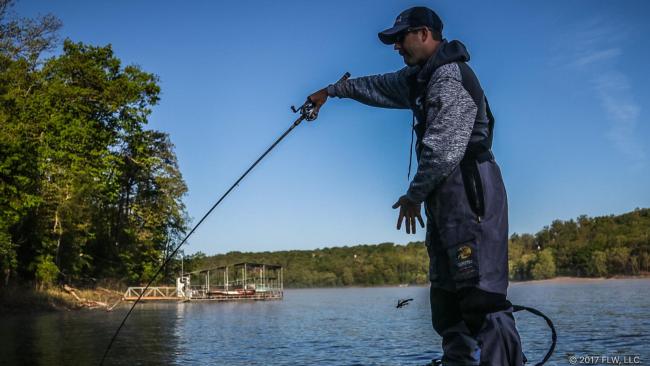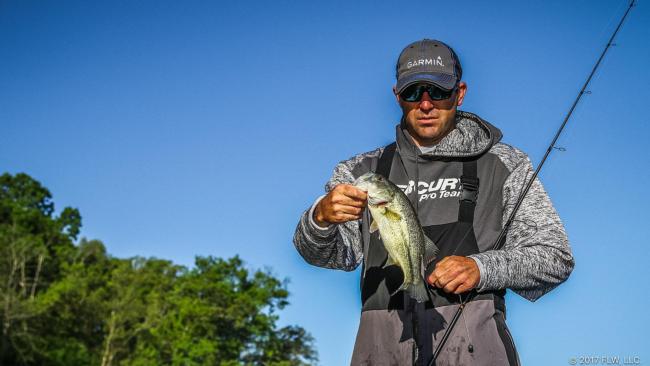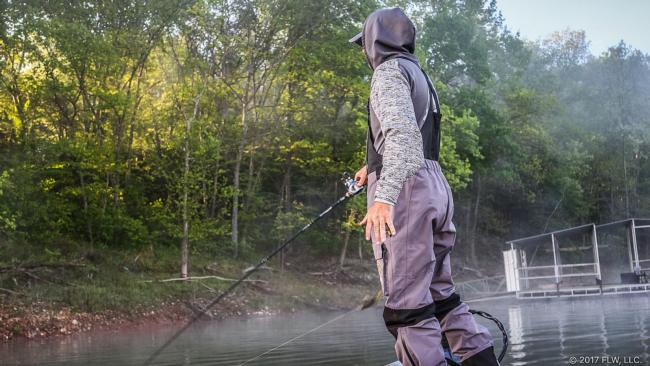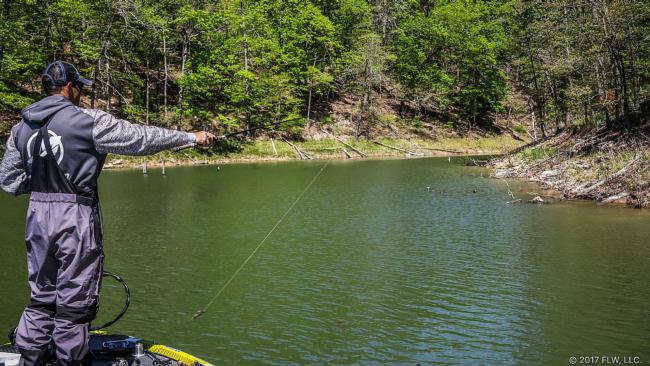Practicing with Scanlon on Beaver
Get to know the third-ranked pro in the AOY standings
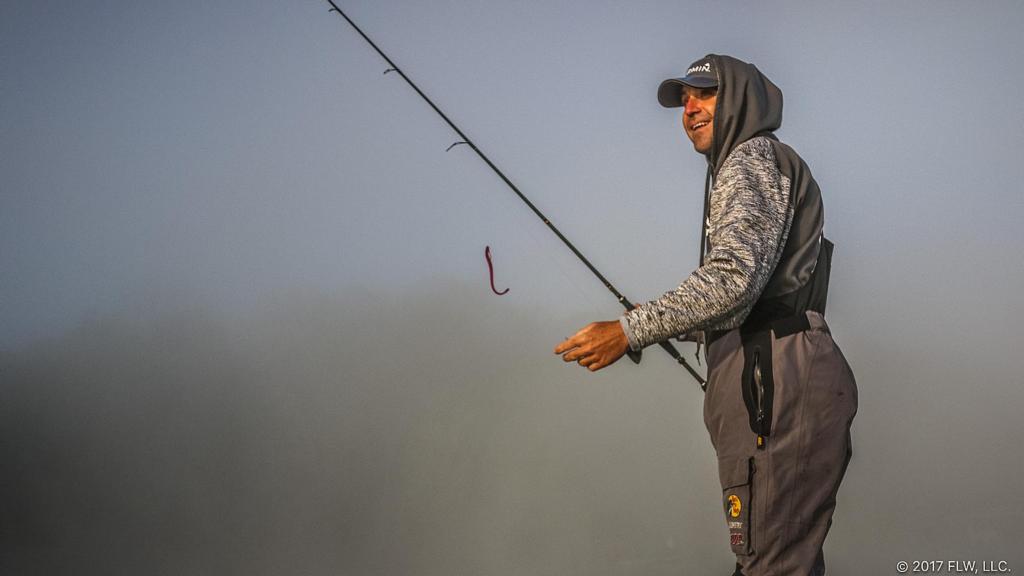
Casey Scanlon’s first FLW Tour season is off to a blistering start. He’s currently third in the Angler of the Year (AOY) standings, he’s had one top 10 finish, two top 20s, and he’s cashed a check in every tournament thus far, to the tune of $50,500. But perhaps more impressive is how Scanlon has improved over the course of the season. After finishing 48th at Guntersville, Scanlon’s placements have gotten progressively higher with each tournament: 19th at Travis, 18th at the Harris Chain, and 8th at Cumberland.
It’s the best start Scanlon’s ever had as a pro angler, including his five years fishing the B.A.S.S. Elite Series, but according to Scanlon, it took slowing things down to speed them up.
“I’ve always been a run, run, run guy, but I’ve forced myself to slow down this year, fish more deliberately, and really milk an area, and it’s paid off for me,” says the 32-year-old Lenexa, Kan. pro, who, prior to turning pro six years ago, spent eight years running a Kansas City landscaping company while fishing local tournaments and dreaming of someday fishing full-time.
“Sure, I dreamed about it,” says Scanlon, as he flips a jig along the bank of Beaver Lake Monday during the second day of practice at the FLW Tour event presented by General Tire. “But it was never something I actively planned for, because I had no idea how to do it. I sort of just fell into it, to be honest.”
Scanlon’s semi-accidental tumble into the top tier of professional fishing began, like so many pros, on the banks of local farm ponds around his childhood home near Kansas City. He caught the fishing bug thanks to both his grandfathers, and entered his first club tournament at age 15. Not long afterward, Scanlon won his first local tournament and was hooked on the keen sense of competition tournament fishing provided. He began entering all the local tournaments and regional pro-ams he could find.
After college at Kansas University, where he majored in communications, Scanlon opened up his landscaping company, but continued fishing tournaments and winning his share of prize money and boats before entering his first B.A.S.S. Open.
“When I set out to fish the Opens, it wasn’t necessarily to try to qualify for the Elite Series, it was just to fish against better competition and have fun and win some money,” he says.
Scanlon won the 2012 B.A.S.S. Central Open on Table Rock Lake, which earned him a spot at the 2013 Bassmaster Classic and really kickstarted his professional career.
“I really had no intention of fishing professionally, but I decided to give it a shot and I haven’t looked back since. It beats mowing grass and building retaining walls.”
Scanlon, who now guides on Table Rock when he’s not fishing Tour events, has – so far – had a rough practice at Beaver, as he concentrates on simply trying to find some semblance of order on a lake that lately has been in a constant state of flux.
“Obviously, the lake is up from all the rain they’ve had,” says Scanlon, “and I think the real question for this tournament is how much more rain are we going to get and how fast is that mud in the river going to come down this way? Right now it doesn’t seem like they’re drawing much water at the dam, but this is going to be a tournament where the water’s going to be coming up and down, so a guy is gonna have to stay on his toes.”
As he speaks Scanlon boats his first keeper of the morning, a spotted bass, flipping a finesse worm along a dock in Prairie Creek.
“I found a couple brush piles yesterday and caught some good fish,” he says, ‘but I’ve had to slow it down quite a bit. It seems that my bites are mostly coming that way. The high water makes it tough to recognize bank transitions, which I think are key right now.”
Scanlon is having the same issue in practice that almost all the anglers are having, namely, finding something, anything, that works. Rising water levels and unseasonable weather have blown up all the usual assumptions about what should be working right now.
“I just haven’t dialed into anything,” he says. “Yesterday I was just bouncing around, trying to get a clue. This time of year you want to focus on pockets or areas where they’re spawning. Largemouths are going to be back in the pockets and I think that’s what it’s going to take to win, so today I’m trying to focus on that and just to try to find a place I could maybe go catch 11 or 12 pounds to start to the tournament.”
Scanlon says he rarely pre-practices or gleans info from locals, simply because things can and often do change so much between then and tournament time.
“You could have come up here a week ago and spent a bunch of time and energy looking for fish, and then come back this week and it’s five feet higher. Ozark lakes are so conditional and change all the time, and I think sometimes you can get too dialed in practice, and when things change you’re reluctant to change with it.”
As we go along the bank Scanlon switches between a jig, a worm and a jerkbait, working docks, small cuts, and laydowns before pulling up and relocating to a point off the main creek arm, where he picks up another fish on a jig.
“These secondary points are good all the time, but this time of year you can catch them coming and going,” he says. “It seems like the fish are wanting to spawn, but I think the ones that were spawning got covered up with the lake coming up so much. We just need the water to stabilize.”
As he fishes, Scanlon reflects on the year he’s having and what it’s taken to get him there. Sure, slowing down and becoming a more methodical angler has helped, but Scanlon says a revamped mental game has had just as much to do with his success.
“This is one of the few sports where you don’t have a coach telling you what you’re doing wrong,” he explains. “You make your own game plan, and your success or failure is all on you, so you’ve got to have a positive attitude about everything. It’s the single most important thing you can have. It’s easy to let things get to you and get a bad attitude, get worked up over a fish you lost. I’ve lost some big fish this year, but I honestly can’t remember a single one. You’ve got to put that out of your mind and instead focus on what you need to do every day on the water. That’s what I’ve done this year – I’ve made it much more of a mental game for myself.”
To that end, Scanlon says he’s also trying not to think too much about points, rankings, and awards.
“I try to take it tournament by tournament. I try not to look at or think about points standings too much. You can’t do that in this game. Not worrying about it helps keep things simple and makes it less of a mind game.”
In terms of fishing style, Scanlon doesn’t much go in for labels. “I don’t really know, to be honest. I generally prefer to fish shallow and throw a crankbait, a jerkbait, or a jig. But at the same time I’ve had a lot of success fishing deep. I like to consider myself a pretty versatile angler, because after you do this for a few years and see a lot of different lakes, you pretty much have to get decent at everything.”
After a couple hours spent probing a creek arm in the mid-lake area Scanlon relocates to a different creek arm upriver where he continues flipping docks and debris mats in the backs of cuts.
“I think figuring out spawn stage, water clarity and water level is going to be key,” he says. “Water clarity in particular is going to be changing depending on what happens with the weather and drawdown through the dam. You’re going to have to force yourself to make changes during the tournament.”
Scanlon says he hasn’t seen a lot of spawning activity, but thinks a lot of fish are going to move up during the event.
“I think there’s going to be a little bit of everything going on,” he says.
But what does he think it will take to win?
“It’d be hard to bet against a jig again, and if we get weather a spinnerbait might play,” he says. “Weight-wise, before this week I would have said about 60 pounds, but now it’s hard to say. I’m gonna guess around 55 pounds because it just seems pretty tough for this time of year.
“After two days of practice I’m still not a whole lot closer, I’m still searching. I think to make it to the last day you’re gonna have to play it by ear every single day and do different things every day to put them in the boat.”
Tournament details
Format: All pros and co-anglers will compete for two days. The co-angler champion will be crowned on day two, and the field will be cut to the top 20 pros on day three and the top 10 pros on day four. The winners will be determined by total cumulative weight.
Takeoff Time: 6:30 a.m. CT
Takeoff Location: Prairie Creek Recreation Area, 9300 North Park Road, Rogers, AR
Weigh-In Time: 3 p.m. CT on days one and two; 4 p.m. CT on days three and four
Weigh-In Location: Prairie Creek all days
Check out the FLW Expo and Evinrude Test Rides
Test rides – Evinrude will be hosting test rides for its popular E-TEC G2 motors at Prairie Creek Recreation Area on Saturday, April 29, from 7 to 11 a.m. All participants will receive a free Evinrude hat. Come demo Evinrude’s most powerful and fuel-efficient two-stroke motor in history.
Expo – The FLW Expo will take place at Prairie Creek on Saturday and Sunday, April 29-30, from 12 to 4 p.m. Kids’ activities include a Ranger Boat simulator, casting pond and more. Concessions will be available, along with vendors selling tackle and other outdoor gear.

